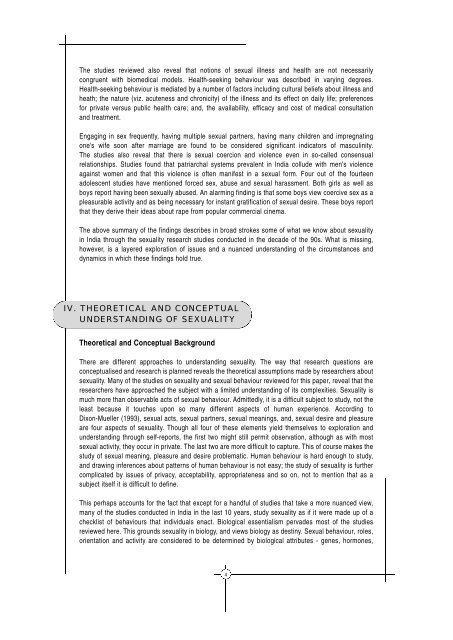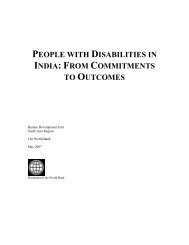FREE Download - TARSHI
FREE Download - TARSHI
FREE Download - TARSHI
Create successful ePaper yourself
Turn your PDF publications into a flip-book with our unique Google optimized e-Paper software.
The studies reviewed also reveal that notions of sexual illness and health are not necessarily<br />
congruent with biomedical models. Health-seeking behaviour was described in varying degrees.<br />
Health-seeking behaviour is mediated by a number of factors including cultural beliefs about illness and<br />
heath; the nature (viz. acuteness and chronicity) of the illness and its effect on daily life; preferences<br />
for private versus public health care; and, the availability, efficacy and cost of medical consultation<br />
and treatment.<br />
Engaging in sex frequently, having multiple sexual partners, having many children and impregnating<br />
one's wife soon after marriage are found to be considered significant indicators of masculinity.<br />
The studies also reveal that there is sexual coercion and violence even in so-called consensual<br />
relationships. Studies found that patriarchal systems prevalent in India collude with men's violence<br />
against women and that this violence is often manifest in a sexual form. Four out of the fourteen<br />
adolescent studies have mentioned forced sex, abuse and sexual harassment. Both girls as well as<br />
boys report having been sexually abused. An alarming finding is that some boys view coercive sex as a<br />
pleasurable activity and as being necessary for instant gratification of sexual desire. These boys report<br />
that they derive their ideas about rape from popular commercial cinema.<br />
The above summary of the findings describes in broad strokes some of what we know about sexuality<br />
in India through the sexuality research studies conducted in the decade of the 90s. What is missing,<br />
however, is a layered exploration of issues and a nuanced understanding of the circumstances and<br />
dynamics in which these findings hold true.<br />
IV. THEORETICAL AND CONCEPTUAL<br />
UNDERSTANDING OF SEXUALITY<br />
Theoretical and Conceptual Background<br />
There are different approaches to understanding sexuality. The way that research questions are<br />
conceptualised and research is planned reveals the theoretical assumptions made by researchers about<br />
sexuality. Many of the studies on sexuality and sexual behaviour reviewed for this paper, reveal that the<br />
researchers have approached the subject with a limited understanding of its complexities. Sexuality is<br />
much more than observable acts of sexual behaviour. Admittedly, it is a difficult subject to study, not the<br />
least because it touches upon so many different aspects of human experience. According to<br />
Dixon-Mueller (1993), sexual acts, sexual partners, sexual meanings, and, sexual desire and pleasure<br />
are four aspects of sexuality. Though all four of these elements yield themselves to exploration and<br />
understanding through self-reports, the first two might still permit observation, although as with most<br />
sexual activity, they occur in private. The last two are more difficult to capture. This of course makes the<br />
study of sexual meaning, pleasure and desire problematic. Human behaviour is hard enough to study,<br />
and drawing inferences about patterns of human behaviour is not easy; the study of sexuality is further<br />
complicated by issues of privacy, acceptability, appropriateness and so on, not to mention that as a<br />
subject itself it is difficult to define.<br />
This perhaps accounts for the fact that except for a handful of studies that take a more nuanced view,<br />
many of the studies conducted in India in the last 10 years, study sexuality as if it were made up of a<br />
checklist of behaviours that individuals enact. Biological essentialism pervades most of the studies<br />
reviewed here. This grounds sexuality in biology, and views biology as destiny. Sexual behaviour, roles,<br />
orientation and activity are considered to be determined by biological attributes - genes, hormones,<br />
4










